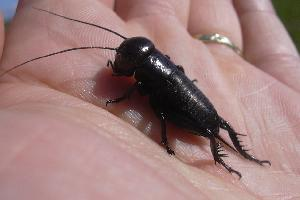
Poids et mesures
| Longueur | de 16 à 20 mm |
|---|
Description de l'animal
The House cricket, scientifically known as Acheta domesticus, is a fascinating insect that has garnered attention for both its ubiquitous presence in human habitats and its importance in ecological systems and as a food source in some cultures. This species of cricket belongs to the order Orthoptera, which includes crickets, grasshoppers, and their relatives. Characterized by their chirping sound, which is predominantly produced by males as a mating call, house crickets are an integral part of the night-time chorus in many parts of the world.Physical Description
Adult house crickets typically measure about 16 to 21 millimeters in length. They possess a light yellowish-brown body covered in fine, dark speckling, which provides them with excellent camouflage against the soil and leaf litter of their natural environment. One of the most distinctive features of the house cricket, as with all crickets, is their long, slender antennae, which can be as long as or longer than their body. This feature is crucial for their navigation and sensory perception, allowing them to detect vibrations and smells in their environment.
House crickets have a robust body structure with a head that houses large compound eyes and mouthparts adapted for chewing. Their thorax bears three pairs of legs and two pairs of wings. The hind legs are particularly large and adapted for jumping, a common escape mechanism when they feel threatened. The wings are used not only for short flights but also for producing their characteristic chirping sound. Males have a ridged vein on their wings which they rub together, a process known as stridulation, to produce chirping sounds that attract females or assert dominance.
Habitat and Distribution
Originally native to Southwest Asia, the house cricket has spread worldwide, largely due to human activity. They are now found in many temperate and tropical regions, thriving in environments modified by humans. They prefer warm conditions and are often found in and around human dwellings, hence their common name. House crickets typically seek out dark, warm, and moist areas, such as basements, kitchens, and around garbage disposal areas where they can find food and shelter.
Diet and Behavior
House crickets are omnivorous, feeding on a wide range of organic materials. Their diet includes plant matter, fungi, and small seedlings, as well as other insects, both alive and dead. In domestic settings, they may consume food scraps, crumbs, and even fabric or paper materials. Their feeding habits make them both beneficial for natural waste decomposition and potentially harmful pests in homes and commercial properties.
Socially, house crickets are generally solitary but can be found in larger numbers when conditions are favorable. They are nocturnal, being most active during the night when they forage for food and males perform their chirping serenades to attract mates.
Reproduction
The reproductive cycle of the house cricket begins with the male's chirping to attract a female. After mating, the female lays her eggs in damp soil or another suitable medium. The eggs hatch into nymphs, which resemble miniature adults but without wings. These nymphs undergo a series of molts, shedding their exoskeleton several times as they grow. After the final molt, they emerge as winged adults, ready to continue the cycle.
Economic and Ecological Importance
House crickets have a mixed reputation among humans. They are considered pests in homes and agricultural settings due to their consumption of crops and fabric materials. However, they are also farmed on a large scale for use as food for pets and zoo animals, and in some cultures, they are even consumed by humans, being a rich source of protein and other nutrients. Ecologically, house crickets play a role in nutrient cycling by decomposing plant and animal material.
In conclusion, the house cricket, Acheta domesticus, is a small but significant creature that exemplifies the complex interactions between species and their environments. Despite their potential as pests, their ecological role and value in various human industries highlight the intricate balance of nature and the importance of understanding and managing insect populations responsibly.
Animaux similaires
Nouvelles photos d'animaux
Top 10 des animaux
- Dolphin gull (Leucophaeus scoresbii)
- Diana monkey (Cercopithecus diana)
- Moustached guenon (Cercopithecus cephus)
- Galápagos tortoise (Geochelone nigra complex)
- Russian tortoise (Testudo horsfieldii)
- Stone loach (Barbatula barbatula)
- Japanese macaque (Macaca fuscata)
- Greek tortoise (Testudo graeca)
- Common flying dragon (Draco volans)
- Vendace (Coregonus albula)
